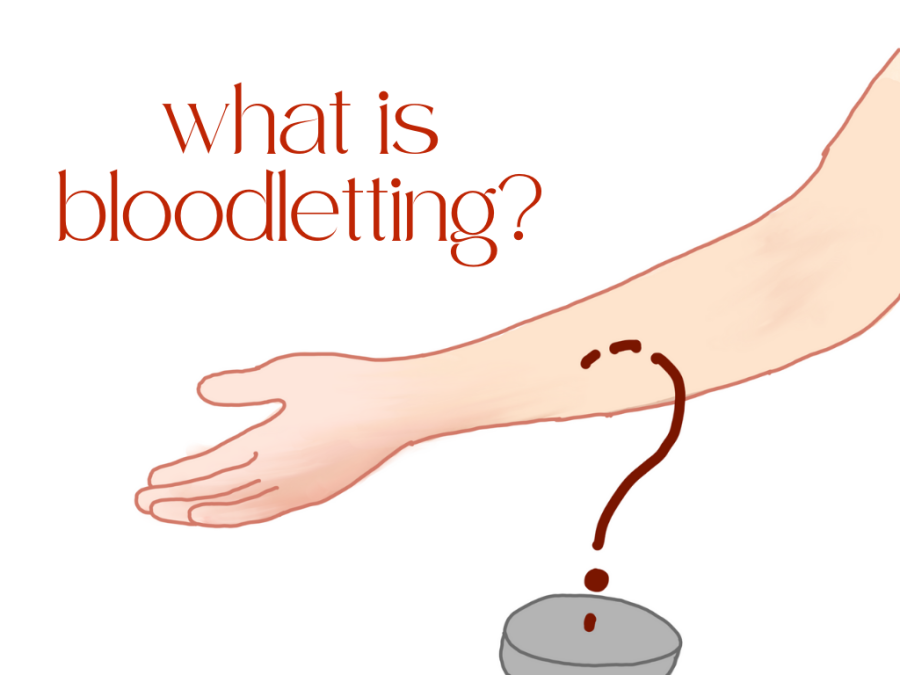Taking a look into the past and present of medicine’s ancient “cure-all”
Regarded in ancient times as a medicinal cure-all, bloodletting has had an interesting history and evolution.
Recently, my English class finished reading Shakespeare’s play Othello. We had to write an in-class essay discussing one of its motifs, and I chose blood. During my research session on blood during Shakespearean times, I came across the term “bloodletting” in what the article author described to be the release of blood from a patient to enable therapeutic effects. An old portrait of a man dressed as a medieval doctor squeezing another man’s arm, which was gushing an alarming amount of blood into a bowl, accompanied the given definition. As with many depictions of old medicinal practices, I was both appalled and disgustingly interested. What exactly was bloodletting? Where did it come from? What did it treat? Who performed it? Who was it performed on?
Bloodletting can be traced to at least 3,000 years ago and is said to have started with the Egyptians. It would spread throughout the West, establishing itself as a prominent part of medicinal practices. Bloodletting became a standard used to treat diseases and other ailments.
With modern-day knowledge, it might be difficult to comprehend how what looks like a medieval torture method had many alleged health benefits. In order to have a better understanding, you need to familiarize yourself with the medicinal ideologies of that time, particularly the theory of the four “humors”. It was a theory first developed by the Greek physician Hippocrates and later expanded on by another Greek physician Galen, who proposed that blood was the most dominant humor and wrote medicinal texts that made bloodletting an even more important common practice. Simplified, it was the idea that a balance of the four “humors”, black bile, yellow bile, phlegm, and blood, was the key to good health. Each one was connected to an organ in the body: the spleen, gallbladder, lung, and brain respectively. Feeling ill was an indication that your “humors” were not balanced. Releasing blood became the most popular means of finding balance among other treatments such as purging, vomiting, and starving.
Bloodletting was performed using two different methods: venesection and arteriotomy, with venesection being more common. Venesection involved a cut being made, typically at the median cubital vein at the elbow, and releasing blood into a bowl. Fleams – tools with multiple fixed blades that varied in size – were used for large cuts. Lancets, two-edged instruments with fine blades that physicians would carry in a case, were also used but harder to sharpen than fleams. Arteriotomy involved using cupping or leeches to draw out blood. The first part of the process was scarification, when the skin was scraped with a scarificator that held multiple small blades designed to make narrow, quick, and painless punctures. The next part was cupping, when dome-shaped glass was placed over the skin to extract air through suction or prior heating. It was called dry cupping when they were heated to dilate blood vessels just under the skin. It was called wet cupping when the dilated vessels were lanced with a blade first before blood was extracted with a heated cup by means of creating a vacuum. If leeches were used instead of cups, it was typically the medicinal leech Hirudo medicinalis.
As a practice, bloodletting had an interesting run in history. When the Black Death ravaged Europe between 1347-1352 CE, bloodletting was one of the many methods first used to try to prevent and treat the plague. Unfortunately, it was ineffective at killing the bacteria and instead weakened patients as well as spread more illness through unsterilized equipment. In 1685, Charles II suffered a sudden seizure. His physician treated him with bloodletting through venesection and cupping. He continued having seizures and was bled a second time before entering a coma from which he never woke up. When Marie-Antoinette fainted while giving birth to her first child in 1778, the surgeon performed bloodletting using a lancet. She was immediately revived but it was probably because the windows were opened, letting fresh air into the room. In 1799, George Washington woke up with a sore throat, fever, and respiratory troubles. He was treated with laxatives, blisterings, emetics, and bloodletting during which physicians drained 5 to 7 pints of blood from him in less than 16 hours. He died the day after his health started declining. Speculations suggest it was sped up due to the excessive blood loss.
Despite its historical controversy and legacy of harm, controlled bloodletting is still used today in Western medicine to treat particular blood abnormalities. This includes hemochromatosis, a genetic disorder when someone’s blood contains too much iron, as well as polycythemia vera, which is a stem cell bone marrow disorder that leads to the overproduction of red blood cells. Medicinal leeches are used today to remove blood buildup in a certain place and can help prevent tissue necrosis (death of tissue). They are often used after micro and reimplantation surgeries. You might know them best for being used with skin grafts.
Bloodletting is a great example of how far medicine has come. Will society centuries from now see our practices as absurd as well?


